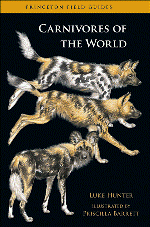Wild Tracks
On behalf of the world's wild species
Polar Ecosystem
At the very top and bottom of the world are vast expanses of wind swept, treeless land. Almost all of Antarctica and much of the Arctic is permanently covered with a thick layer of ice.
The polar regions of the world are always cold because at these high latitudes, the sun never rises far above the horizon, and its rays only glance across the earth. What little solar energy does manage to reach the surface is reflected back into space by the bright white ice.
The Antarctic
The ecological stability of the Antarctic is based on the presence of ice. Any change in the environment that reduces the amount of ice will irreversibly modify the entire ecosystem. Rises in ocean temperatures break up coastal ice, endangering seals, penguins and krill, which graze on the algae attached to the ice.
The Antarctic ecology is dominated by the sea. Tiny shrimp-like crustaceans called krill live in the top 45 metres (150 ft) of the ocean in their countless billions. Krill are the center of the Antarctic Ocean’s food web, providing the bulk of the diet for blue whales, fur seals, penguins, albatross and fish. The current intensity of human fishing for krill, combined with heating of the ocean from a thinning ozone layer, could lead to an overall decline in their population, which would have repercussions all the way up the food chain.
Animal Adaptations
In this coldest of the world’s habitats, animals that survive here have some outstanding adaptations. The most famous inhabitants of Antarctica – Emperor penguins – have developed a co-operative behavioural strategy for survival during the unceasing icy winds. Huddling together in the thousands to keep each other warm, individuals constantly take turns to stand on the exposed fringes before returning to the heat in the interior of the group. Emperor’s do not build nests, but keep their single egg off the ice by holding it on top of their feet, underneath the warm skin flap of the parent bird.
Life in the frigid oceans also requires special adaptations. The protective guard hair of a fur seal may have up to 50 or more soft hairs growing from the follicle to help trap air next to the body. Like animals in the northern polar areas, sea mammals in the Antarctic oceans also have an extra layer of fat and thicker fur.
Effects of Global Warming on The World’s Polar Areas
- Atmospheric transportation of pollutants is now global – PCB’s have been found in the fat of Antarctic penguins; pesticides and industrial effluents in arctic animals
- Right whales – so called by early whalers because they gave the longest whalebones and thickest blubber – have been hunted nearly to extinction. They mate in the seas off Patagonia in bays now threatened by oil and gas development.
- Pollution from mining and oil drilling in the Arctic has polluted the air, lakes and rivers
- More people moving to the tundra to work the mines and oil rigs have created towns and more roads, which disrupt seasonal movements of large animals, and bring them into close contact with humans. Rubbish left from Antarctic explorers that wasn’t carried out takes so long to decompose in the frigid temperatures that mountains of it are piling up
- Higher temperatures in the Arctic are drying up ponds that have been home to aquatic wildlife for millennia. The year 2006 was 3.5C (37F) warmer than the past 30 year average, causing high evaporation of ponds on Ellesmere Island, which have been monitored since 1983.
